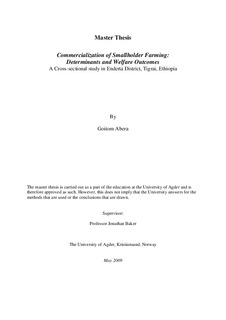| dc.description.abstract | Transforming the subsistence-oriented production system into a market-oriented production
system as a way to increasing the smallholder farmer’s income and thus its welfare outcomes,
and reducing rural poverty, has been in the policy spotlight of many developing countries,
including Ethiopia, for some time now. However, there are no adequate studies in Tigrai
focusing on the level of market integration of the smallholder farmers and whether the market
participants are better-off in welfare outcomes. This study, thus, focused on identifying the
micro-level factors determining market participation, the level of commercialization as well
as evaluating the welfare outcomes of participant smallholders in Enderta District of Tigrai.
Descriptive, statistical and econometric methods were employed to analyze the data collected
from a sample of 125 households using structured household questionnaires. The findings
from the statistical analysis showed that landholding size and land slope, irrigation use,
number of oxen owned, and membership in extension package program have positive and
significant association with commercialization while participation in non-farm activities has
significant but negative association with commercialization. Nonetheless, descriptive findings
showed that the degree of commercialization in the study area is very low (23%) even in
comparison to the national average (33-36%), which is in itself considered to be low. The
findings from the probit regression analysis revealed that production level (in value terms),
use of improved seeds, use of irrigation and total landholding size are the most important
factors affecting the ability of a smallholder to participate in output markets. Moreover, the
findings from OLS estimation showed that the level of food and cash crop production (in
value terms), gender, technology use (irrigation, improved seeds), use of fertilizer and the
number of oxen owned per household are important factors determining the level of
commercialization of smallholder farms. Finally, findings from one-way ANOVA analysis
indicated that farm households with high degree of commercialization enjoyed better welfare
outcomes (represented by consumption of basic non-grain consumables and expenditure on
education, shoes and clothes, durables and housing). Therefore, the findings indicate that
farmers with high level of commercialization are better-off in welfare outcomes. In addition,
the findings indicate that farmers can be better integrated with the market if better support
services are provided and efforts to enhance farmers’ access to technology and assets are
strengthened.
Key words: Smallholder, Commercialization, Welfare, Subsistence farming, Probit model,
OLS estimation, Enderta- Tigrai | en |
